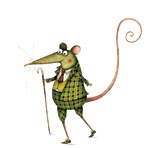Country mouse on rosehips
Mark is reminded of all the traditional uses for rosehips


I don't know anyone who makes rosehip syrup anymore, but both during and after the Second World War, children were paid a few pence for collecting a bag of the hips to make into the syrup. It is extremely rich in vitamin C, an essential which was in short supply at the time.
The hips also have another use, one that I had forgotten until my children, oh so kindly, reminded me. The seeds of the hips act as a highly effective itching powder, and, placed unnoticed in my socks, caused feverish scratching and much merriment until my daughter, Anna, eventually admitted the prank.
There are all sorts of high jinks to be had in the autumn. Supreme among them are conker fights. The Michaelmas term at my prep school was dominated by conkers and carols. I hope the current headmaster at the school hasn't gone all namby-pamby and banned the mighty conker fights. Holding a conker dead still as your opponent takes a mighty swipe at it is a test of nerve that does nobody any harm.
We have ended up with a society that worries feverishly about our children taking risks, but worries little about the experiences and adventures that we deny them.
Sign up for the Country Life Newsletter
Exquisite houses, the beauty of Nature, and how to get the most from your life, straight to your inbox.
Country Life is unlike any other magazine: the only glossy weekly on the newsstand and the only magazine that has been guest-edited by HRH The King not once, but twice. It is a celebration of modern rural life and all its diverse joys and pleasures — that was first published in Queen Victoria's Diamond Jubilee year. Our eclectic mixture of witty and informative content — from the most up-to-date property news and commentary and a coveted glimpse inside some of the UK's best houses and gardens, to gardening, the arts and interior design, written by experts in their field — still cannot be found in print or online, anywhere else.
-
 Six rural properties with space, charm and endless views, as seen in Country Life
Six rural properties with space, charm and endless views, as seen in Country LifeWe take a look at some of the best houses to come to the market via Country Life in the past week.
By Toby Keel
-
 Exploring the countryside is essential for our wellbeing, but Right to Roam is going backwards
Exploring the countryside is essential for our wellbeing, but Right to Roam is going backwardsCampaigners in England often point to Scotland as an example of how brilliantly Right to Roam works, but it's not all it's cracked up to be, says Patrick Galbraith.
By Patrick Galbraith